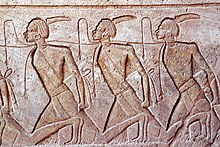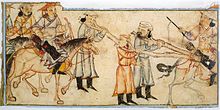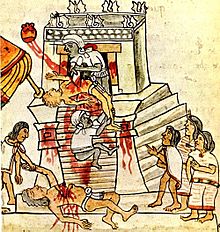
A | B | C | D | E | F | G | H | CH | I | J | K | L | M | N | O | P | Q | R | S | T | U | V | W | X | Y | Z | 0 | 1 | 2 | 3 | 4 | 5 | 6 | 7 | 8 | 9

| Part of a series on |
| War Outline |
|---|
 |
A prisoner of war (POW) is a person who is held captive by a belligerent power during or immediately after an armed conflict. The earliest recorded usage of the phrase "prisoner of war" dates back to 1610.[a]
Belligerents hold prisoners of war in custody for a range of legitimate and illegitimate reasons, such as isolating them from the enemy combatants still in the field (releasing and repatriating them in an orderly manner after hostilities), demonstrating military victory, punishing them, prosecuting them for war crimes, exploiting them for their labour, recruiting or even conscripting them as their own combatants, collecting military and political intelligence from them, or indoctrinating them in new political or religious beliefs.[1]
Ancient times

For a large part of human history, prisoners of war would most often be either slaughtered or enslaved.[2] Early Roman gladiators could be prisoners of war, categorised according to their ethnic roots as Samnites, Thracians, and Gauls (Galli).[3] Homer's Iliad describes Trojan and Greek soldiers offering rewards of wealth to opposing forces who have defeated them on the battlefield in exchange for mercy, but their offers are not always accepted; see Lycaon for example.
Typically, victors made little distinction between enemy combatants and enemy civilians, although they were more likely to spare women and children. Sometimes the purpose of a battle, if not of a war, was to capture women, a practice known as raptio; the Rape of the Sabines involved, according to tradition, a large mass-abduction by the founders of Rome. Typically women had no rights, and were held legally as chattels.[4][need quotation to verify]
In the fourth century AD, Bishop Acacius of Amida, touched by the plight of Persian prisoners captured in a recent war with the Greek Empire, who were held in his town under appalling conditions and destined for a life of slavery, took the initiative in ransoming them by selling his church's precious gold and silver vessels and letting them return to their country. For this he was eventually canonized.[5]
Middle Ages and Renaissance

According to legend, during Childeric's siege and blockade of Paris in 464 the nun Geneviève (later canonised as the city's patron saint) pleaded with the Frankish king for the welfare of prisoners of war and met with a favourable response. Later, Clovis I (r. 481–511) liberated captives after Genevieve urged him to do so.[6]
King Henry V's English army killed many French prisoners of war after the Battle of Agincourt in 1415.[7] This was done in retaliation for the French killing of the boys and other non-combatants handling the baggage and equipment of the army, and because the French were attacking again and Henry was afraid that they would break through and free the prisoners who would rejoin the fight against the English.
In the later Middle Ages a number of religious wars aimed to not only defeat but also to eliminate enemies. Authorities in Christian Europe often considered the extermination of heretics and heathens desirable. Examples of such wars include the 13th-century Albigensian Crusade in Languedoc and the Northern Crusades in the Baltic region.[8] When asked by a Crusader how to distinguish between the Catholics and Cathars following the projected capture (1209) of the city of Béziers, the papal legate Arnaud Amalric allegedly replied, "Kill them all, God will know His own".[b]
Likewise, the inhabitants of conquered cities were frequently massacred during Christians' Crusades against Muslims in the 11th and 12th centuries. Noblemen could hope to be ransomed; their families would have to send to their captors large sums of wealth commensurate with the social status of the captive.
Feudal Japan had no custom of ransoming prisoners of war, who could expect for the most part summary execution.[9]

In the 13th century the expanding Mongol Empire famously distinguished between cities or towns that surrendered (where the population was spared but required to support the conquering Mongol army) and those that resisted (in which case the city was ransacked and destroyed, and all the population killed). In Termez, on the Oxus: "all the people, both men and women, were driven out onto the plain, and divided in accordance with their usual custom, then they were all slain".[10]
The Aztecs warred constantly with neighbouring tribes and groups, aiming to collect live prisoners for sacrifice.[11] For the re-consecration of Great Pyramid of Tenochtitlan in 1487, "between 10,000 and 80,400 persons" were sacrificed.[12][13]
During the early Muslim conquests of 622–750, Muslims routinely captured large numbers of prisoners. Aside from those who converted, most were ransomed or enslaved.[14][15] Christians captured during the Crusades were usually either killed or sold into slavery if they could not pay a ransom.[16] During his lifetime (c. 570 – 632), Muhammad made it the responsibility of the Islamic government to provide food and clothing, on a reasonable basis, to captives, regardless of their religion; however, if the prisoners were in the custody of a person, then the responsibility was on the individual.[17] On certain occasions where Muhammad felt the enemy had broken a treaty with the Muslims he endorsed the mass execution of male prisoners who participated in battles, as in the case of the Banu Qurayza in 627. The Muslims divided up the females and children of those executed as ghanima (spoils of war).[18]
Modern times

In Europe, the treatment of prisoners of war became increasingly centralized, in the time period between the 16th and late 18th century. Whereas prisoners of war had previously been regarded as the private property of the captor, captured enemy soldiers became increasingly regarded as the property of the state. The European states strove to exert increasing control over all stages of captivity, from the question of who would be attributed the status of prisoner of war to their eventual release. The act of surrender was regulated so that it, ideally, should be legitimized by officers, who negotiated the surrender of their whole unit.[19] Soldiers whose style of fighting did not conform to the battle line tactics of regular European armies, such as Cossacks and Croats, were often denied the status of prisoners of war.[20]
In line with this development the treatment of prisoners of war became increasingly regulated in international treaties, particularly in the form of the so-called cartel system, which regulated how the exchange of prisoners would be carried out between warring states.[21] Another such treaty was the 1648 Peace of Westphalia, which ended the Thirty Years' War. This treaty established the rule that prisoners of war should be released without ransom at the end of hostilities and that they should be allowed to return to their homelands.[22]
There also evolved the right of parole, French for "discourse", in which a captured officer surrendered his sword and gave his word as a gentleman in exchange for privileges. If he swore not to escape, he could gain better accommodations and the freedom of the prison. If he swore to cease hostilities against the nation who hold him captive, he could be repatriated or exchanged but could not serve against his former captors in a military capacity.
European settlers captured in North America
Early historical narratives of captured European settlers, including perspectives of literate women captured by the indigenous peoples of North America, exist in some number. The writings of Mary Rowlandson, captured in the chaotic fighting of King Philip's War, are an example. Such narratives enjoyed some popularity, spawning a genre of the captivity narrative, and had lasting influence on the body of early American literature, most notably through the legacy of James Fenimore Cooper's The Last of the Mohicans. Some Native Americans continued to capture Europeans and use them both as labourers and bargaining chips into the 19th century; see for example John R. Jewitt, a sailor who wrote a memoir about his years as a captive of the Nootka people on the Pacific Northwest coast from 1802 to 1805.
French Revolutionary wars and Napoleonic wars
Zdroj:https://en.wikipedia.org?pojem=POWsText je dostupný za podmienok Creative Commons Attribution/Share-Alike License 3.0 Unported; prípadne za ďalších podmienok. Podrobnejšie informácie nájdete na stránke Podmienky použitia.
Antropológia
Aplikované vedy
Bibliometria
Dejiny vedy
Encyklopédie
Filozofia vedy
Forenzné vedy
Humanitné vedy
Knižničná veda
Kryogenika
Kryptológia
Kulturológia
Literárna veda
Medzidisciplinárne oblasti
Metódy kvantitatívnej analýzy
Metavedy
Metodika
Text je dostupný za podmienok Creative
Commons Attribution/Share-Alike License 3.0 Unported; prípadne za ďalších
podmienok.
Podrobnejšie informácie nájdete na stránke Podmienky
použitia.
www.astronomia.sk | www.biologia.sk | www.botanika.sk | www.dejiny.sk | www.economy.sk | www.elektrotechnika.sk | www.estetika.sk | www.farmakologia.sk | www.filozofia.sk | Fyzika | www.futurologia.sk | www.genetika.sk | www.chemia.sk | www.lingvistika.sk | www.politologia.sk | www.psychologia.sk | www.sexuologia.sk | www.sociologia.sk | www.veda.sk I www.zoologia.sk
